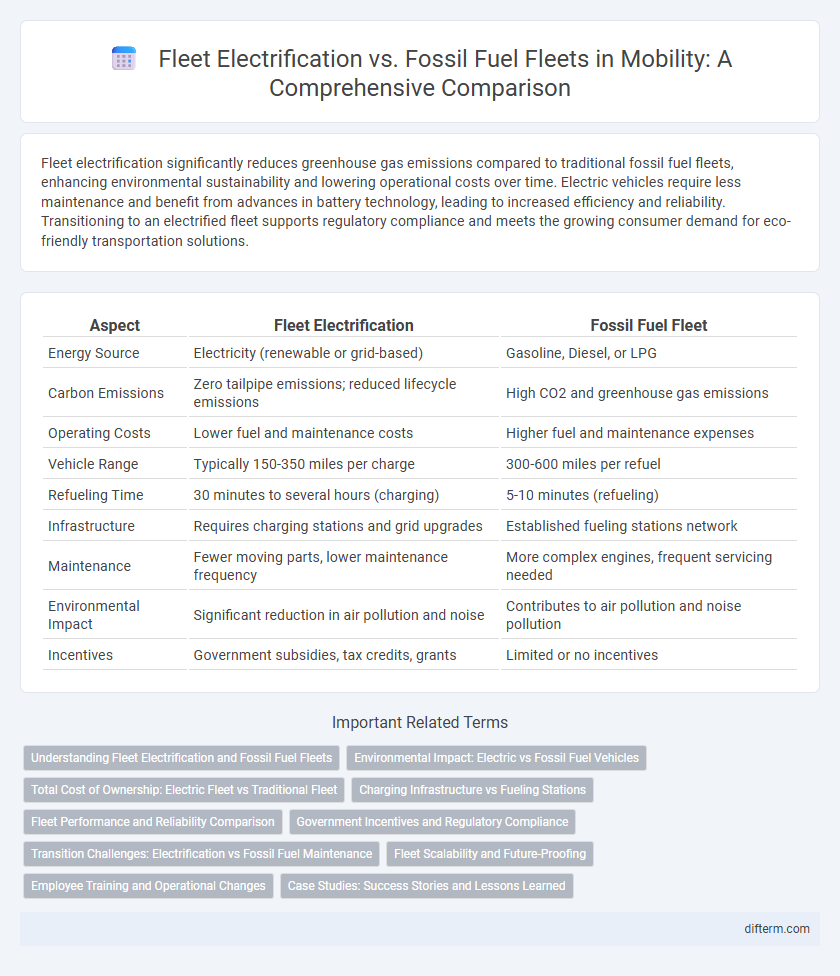Fleet electrification significantly reduces greenhouse gas emissions compared to traditional fossil fuel fleets, enhancing environmental sustainability and lowering operational costs over time. Electric vehicles require less maintenance and benefit from advances in battery technology, leading to increased efficiency and reliability. Transitioning to an electrified fleet supports regulatory compliance and meets the growing consumer demand for eco-friendly transportation solutions.
Table of Comparison
| Aspect | Fleet Electrification | Fossil Fuel Fleet |
|---|---|---|
| Energy Source | Electricity (renewable or grid-based) | Gasoline, Diesel, or LPG |
| Carbon Emissions | Zero tailpipe emissions; reduced lifecycle emissions | High CO2 and greenhouse gas emissions |
| Operating Costs | Lower fuel and maintenance costs | Higher fuel and maintenance expenses |
| Vehicle Range | Typically 150-350 miles per charge | 300-600 miles per refuel |
| Refueling Time | 30 minutes to several hours (charging) | 5-10 minutes (refueling) |
| Infrastructure | Requires charging stations and grid upgrades | Established fueling stations network |
| Maintenance | Fewer moving parts, lower maintenance frequency | More complex engines, frequent servicing needed |
| Environmental Impact | Significant reduction in air pollution and noise | Contributes to air pollution and noise pollution |
| Incentives | Government subsidies, tax credits, grants | Limited or no incentives |
Understanding Fleet Electrification and Fossil Fuel Fleets
Fleet electrification involves transitioning vehicles from fossil fuel engines to electric powertrains, reducing greenhouse gas emissions and operational costs significantly. Fossil fuel fleets rely on internal combustion engines powered by gasoline or diesel, contributing to higher carbon emissions and dependence on fluctuating oil markets. Understanding these differences highlights the environmental and economic benefits of electric fleets, including lower maintenance demands and improved energy efficiency.
Environmental Impact: Electric vs Fossil Fuel Vehicles
Electric vehicles produce zero tailpipe emissions, drastically reducing greenhouse gases and air pollutants compared to fossil fuel fleets. Lifecycle analyses reveal that electric fleets have significantly lower carbon footprints, especially when powered by renewable energy sources. Transitioning to electric mobility also mitigates urban air pollution and supports global climate targets.
Total Cost of Ownership: Electric Fleet vs Traditional Fleet
Electric fleets demonstrate lower Total Cost of Ownership (TCO) compared to traditional fossil fuel fleets due to reduced fuel expenses, lower maintenance costs, and government incentives. Despite higher upfront purchase prices, electric vehicles benefit from regenerative braking and fewer moving parts, decreasing long-term repair and servicing needs. Over the vehicle lifecycle, electric fleet operators can achieve significant savings and improved sustainability metrics compared to conventional internal combustion engine fleets.
Charging Infrastructure vs Fueling Stations
Charging infrastructure for electric fleets offers faster scalability and lower operational costs compared to traditional fueling stations, which require significant space and environmental compliance. Electric vehicle (EV) charging stations can be integrated into various locations such as depots, public spaces, and workplaces, supporting efficient fleet management and reduced downtime. Fossil fuel fueling stations rely on centralized distribution networks and face challenges including fuel price volatility and higher greenhouse gas emissions.
Fleet Performance and Reliability Comparison
Electric fleet vehicles demonstrate higher efficiency with lower maintenance costs compared to fossil fuel fleets, resulting in improved overall fleet performance. Electric drivetrains provide consistent torque and smoother acceleration, enhancing vehicle reliability and uptime. Studies show electric fleets experience fewer mechanical failures, reducing downtime and boosting operational productivity.
Government Incentives and Regulatory Compliance
Government incentives such as tax credits, grants, and rebates significantly reduce the upfront costs of fleet electrification, accelerating adoption compared to fossil fuel fleets. Regulatory compliance increasingly mandates lower emissions and stricter fuel efficiency standards, making electric fleets essential for meeting legal requirements and avoiding penalties. Incentive programs coupled with evolving regulations create a robust framework that financially and operationally favors electric fleet integration over traditional fossil fuel vehicles.
Transition Challenges: Electrification vs Fossil Fuel Maintenance
Fleet electrification presents significant transition challenges compared to fossil fuel fleets, primarily due to the need for new maintenance skills, equipment, and infrastructure. Electric vehicle (EV) batteries require specialized diagnostic tools and expertise in high-voltage systems, unlike traditional internal combustion engine (ICE) maintenance which relies on established mechanical knowledge and readily available parts. The shift also demands investment in charging stations and battery management systems, increasing operational complexity and costs during the transition phase.
Fleet Scalability and Future-Proofing
Electric vehicle (EV) fleets offer superior scalability compared to fossil fuel fleets due to simplified maintenance and modular charging infrastructure, enabling rapid expansion without proportional increases in operational complexity. Battery technology advancements and software-driven energy management systems enhance future-proofing by allowing seamless integration of new vehicle models and renewable energy sources. Transitioning to electrified fleets reduces dependency on volatile fossil fuel markets, ensuring long-term cost stability and regulatory compliance.
Employee Training and Operational Changes
Fleet electrification demands comprehensive employee training programs focused on electric vehicle (EV) maintenance, safety protocols, and energy management systems, contrasting sharply with fossil fuel fleet operations that rely on traditional mechanical skills and fuel handling expertise. Operational changes include updated charging infrastructure planning, real-time energy consumption monitoring, and integration of telematics designed specifically for EV fleets. These shifts drive efficiency improvements, reduce downtime, and enhance sustainability metrics across corporate mobility strategies.
Case Studies: Success Stories and Lessons Learned
Case studies on fleet electrification reveal substantial reductions in carbon emissions and operating costs compared to traditional fossil fuel fleets. Major companies like UPS and DHL have reported improved energy efficiency and maintenance savings by transitioning to electric vehicles, highlighting scalability in urban delivery contexts. Challenges such as upfront investment and charging infrastructure are mitigated through government incentives and strategic planning, offering valuable lessons for widespread adoption.
Fleet electrification vs Fossil fuel fleet Infographic

 difterm.com
difterm.com